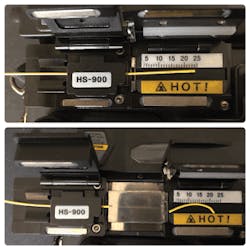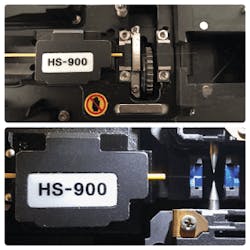Preparing for Workforce Challenges With Better FTTx Installation Training —
In the late 1990s, fiber for the masses was still years away and fiber splicing technicians were akin to astronauts. There were few of them who worked with very environmentally sensitive and specialized devices; training came more by experience than by textbooks. Oftentimes, they forged their way through each unique installation one at a time. These optical technicians were proven copper/coax technicians who were tapped mid-career because they demonstrated the skill, tenacity, and methodology, to do what it took to get things perfect.
Flash forward ahead to today. These "Senior" technicians who led the way, as well as many of those they trained, are retiring in large numbers, leaving an ever-growing drain on the skilled optical technician workforce. Combine this with the exponential increase in fiber deployments by service providers of all types –Telcos, MSOs, Utilities, Municipalities, Contractors, and Private Carriers — all of these network providers are finding themselves in competition to deploy a highly skilled fiber-savvy workforce. It’s no wonder the skilled fiber-tech resource pool is very shallow if not empty.
InvisiLight® Solution for Deploying Fiber
April 2, 2022Go to Market Faster. Speed up Network Deployment
April 2, 2022Episode 10: Fiber Optic Closure Specs Explained…
April 1, 2022Food for Thought from Our 2022 ICT Visionaries
April 1, 2022The current end game for all providers of high-speed services must include fiber, either for the delivery of their services to the end user or for the backhaul of wireless and 5G services from the end user. Up until recently the traditional training methods used for years were replicated until they couldn’t support the volume and quality of installations needed. This led the service providers to entertain many good, bad, and ugly, solutions from equipment manufacturers to use alternative methods of connectivity to avoid or replace fiber splicing.
Many solutions have come and gone, but one principal remains true and constant: the best possible way to connect fiber optic cable still remains melting the glass or fusing it by using a fusion splicer. Operation of a fusion splicer requires training and knowledge and it is a tool that needs to be purchased and cared for. Therefore, becoming a fusion splicer has always been a specialized skill. Which technicians can use fusion splicers varies from company to company, and can even be defined by union work agreements.
The picture on the top is a 900-micron tight buffered fiber in a fiber holder before thermal stripping. The picture on bottom is the same fiber but now stripped with the bare fiber exposed on the left and the tight buffered jacket laying in the thermal stripper. Total stripping time: less than 2 seconds.
One of the current workforce dilemmas is that, until recently, the methods to train fiber technicians were the same as 20 years ago. The multiple step and nuanced skill set required to splice fiber is no longer appealing to the changing workforce demographic. As a result, newer, more efficient standards-based methodologies have been developed that enable shorter training to production level timelines, and enable cross training among platforms of fusion splicers, making the workforce more versatile.
A New Model Needed
Fiber splicing requires good close-up vison and dexterity, the ability to reason and think on your feet, and the patience to be methodical, AKA patience and repetitiveness. This is a "gotcha" as it is akin to boring and tedious — 2 qualities that are detrimental to the currently evolving workforce demographic as a whole for any employee in any industry today. The workforce of the 2020s and beyond wants a career that enables them to be challenged, engaged, and is evolving forward, and, most of all, provides job satisfaction.
As an industry we need to evolve the deployment training processes while adhering to industry standards. We need to replace the boring and tedious so we can attract the transitioning workforce to fusion splicing as a career.
The picture on the top shows the stripped fiber after it’s been cleaned and placed in the cleaver to be cut to length; no measuring is required as the holder provides the exact length every time. The picture on the bottom is the cleaved fiber nested in the fusion chamber, waiting for the other fiber end or a connector so it can be arc fused for the minimum possible loss measurement and best practice connection.
3 Changes
Three of the most significant changes we, and others, have incorporated into our products can increase the quality and speed of the performed tasks — but also appeals to a broader, skilled workforce. A brief description of these 3 methods follows.
1. Use of Fiber Holders
Traditional fusion splicers use fiber clamps, which requires very good dexterity and vision, as well as the added steps of measuring and paying more attention to lengths for stripping and cleaving.
With fiber holders, once the fiber is inserted, it remains there for each of stripping, cleaning, cleaving, and fusing, steps. This methodology eliminates any measuring as the proper cleave lengths are determined by the holders. Seeding the holders into each step of the process is quick, seamless, and the same each and every time, which creates consistent high-quality work with less variation over a diverse work force.
2. Thermal Stripping
Thermal strippers remove the jacket from the fiber to be spliced by heating the jacket and pulling the fiber away from it. This is preferable to using a hand stripper, which is a nuanced skill that is difficult to learn, and can damage and scratch the fiber if not done correctly.
Thermal strippers are always currently used with Ribbon Splicers, which are very expensive. Some companies do offer thermal strippers for their single fiber splicers, which, again, speeds up the process and produces the highest quality measurable result each and every time.
3. Staying in the "Family"
This means utilizing a platform of machines that incorporate the same skill set for the different fusion splicer applications.
• Last Mile FTTx typically uses an active-clad 4-motor machine.
• Mid-Span and longer use core-aligned 6-motor machines.
• High-density mass fusion or ribbon splicing utilizes a 2-motor ribbon splicer to splice 12 fibers at once.
By selecting a family of machines, a tech that is trained on any one of the 3 different types of fusion splicers will rapidly train up on the others as the skills, methods, and metrics, are all very similar.
Training Models
The current model for training is usually centered around a project. Many times, training is delivered close to the project kick-off date, when the technicians need to learn too many disciplines at once in addition to learning how to fusion splice.
• An early fiber skills training is more effective.
• It should then be followed up by a pre-deployment training that is specific in nature to a well-defined project.
• The final phase is an interactive follow-up session that is based on actual field experience of the technicians. This gives all the technicians an opportunity to share their successes and struggles, and to get answers to their individual challenges.
Like this Article?
Subscribe to ISE magazine and start receiving your FREE monthly copy today!
Training technicians with fiber skills helps their individual career progression, which in turn directly benefits their company, which in turn supports the efforts of the industry as a whole.
Utilizing training and deployment methods with well-defined and measurable standardized processes enables quick and easy successes, and eliminates most all of the nuances and monotony. The results are a well-trained reliable field technician work force that ramps up rapidly to deliver consistent high-quality fiber splicing.
Visit our website, https://americailsintech.com/, to contact us, schedule a demo, or learn more about our precision equipment. Join our many followers on LinkedIn: America Ilsintech.






